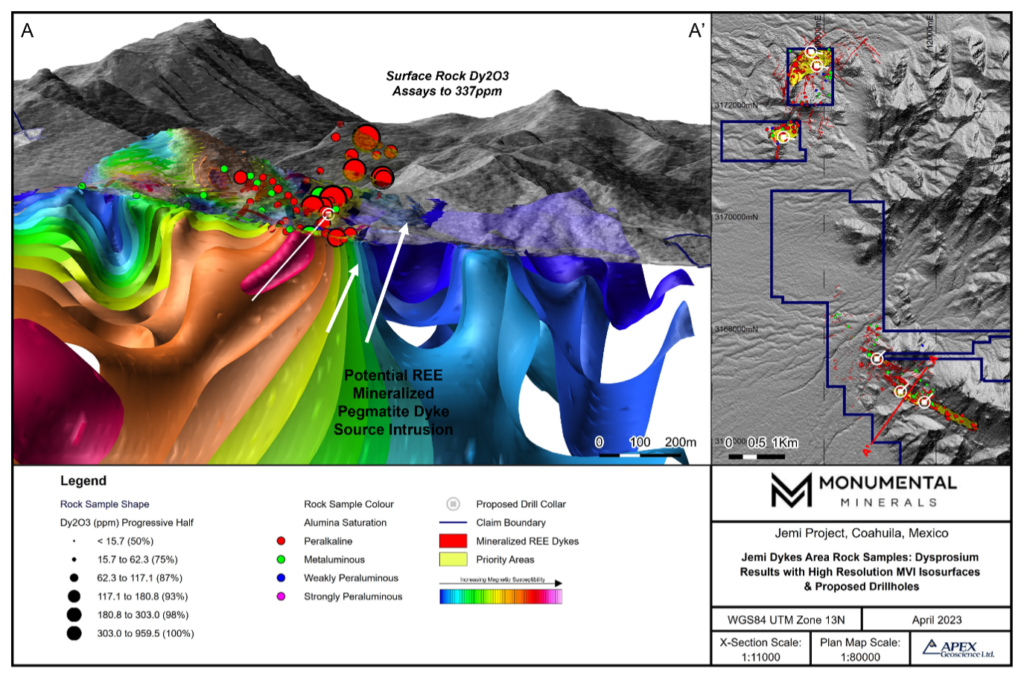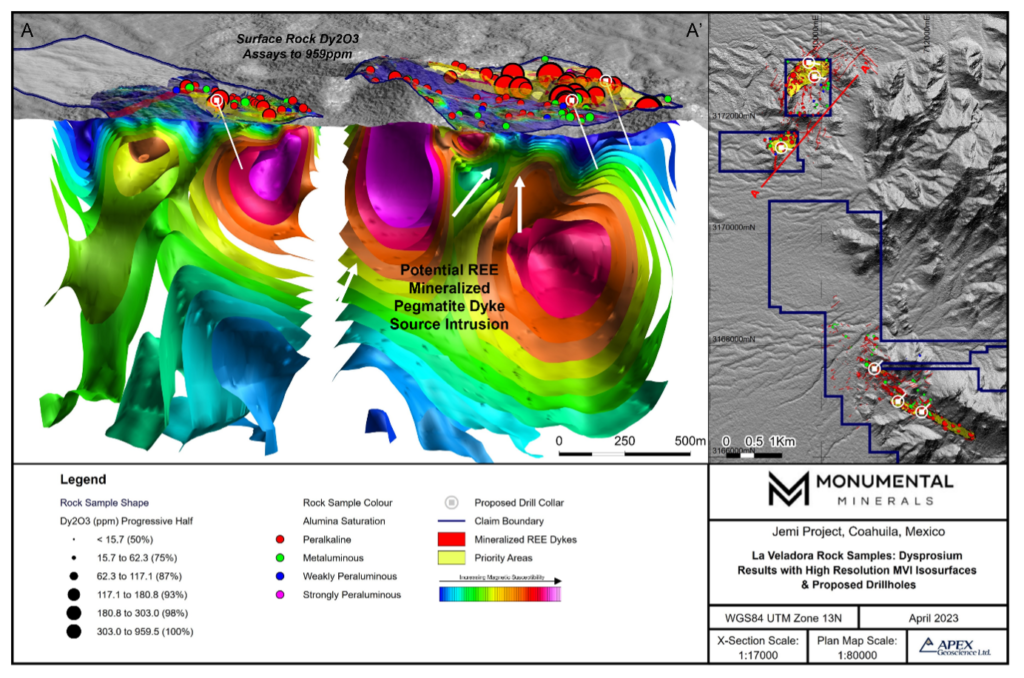Six targets selected for drilling in Q2 2023
News Release – Vancouver, British Columbia – April 4, 2023: Monumental Minerals Corp. (“Monumental” or the “Company”) (TSX-V: MNRL; FSE: BE5; OTCQB: MNMRF) is pleased to report all assay results and proposed drill targets from the Jemi rare earth element (REE) project (the “Project”) in Coahuila, Mexico, about 40 km south of the Texas, USA border. Rock sampling across a broad area discovered high grades of the critical magnet metals dysprosium (Dy) and terbium (Tb) resulting in the definition of 6 high priority drill targets.
Four months of exploration has been completed at Jemi, with the aim of defining discreet drill targets. This work consisted of detailed geological mapping, regional stream sediment sampling, ground radiometric geophysical surveys, and lithogeochemical sampling. Exploration focused on the Jemi Dykes and Veladora North prospect areas, which host peralkaline intrusion related REE mineralization.
A total of 296 assays have been received for surface rock chip samples from Jemi Dykes and Veladora North. Samples that are both peralkaline and anomalous in REEs, Ta, and Nb (116 samples) define four discreet priority areas within Monumental’s mineral concessions (Figure 1 A&B). The priority areas each exhibit high densities of mineralized (eudialyte +/- aegirine rich) intrusive dykes, which have intruded into limestone or marble and range in thickness from 2 to 0.1 m (average of 0.7 m thickness). Three-dimensional modeling of airborne magnetic data (see Company’s news release dated May 3, 2022) indicates that a larger intrusive body and potential source for the mineralized dykes may lie at a shallow depth (less than 300 m) beneath the dykes. Based on these results, six preliminary drill targets have been chosen (Figure 1 A&B) and a drilling program is anticipated to commence in June 2023.
Dr. Jamil Sader, CEO and Director comments:
“Our technical team has succeeded in defining 6 highly prospective drill targets based on mapping, rock chip sampling and geophysics. These targets have similar characteristics to other well defined hardrock peralkaline REE systems globally and we are optimistic that drilling will further define a REE mineralized system below the surface at Jemi. We are planning towards a drilling program at both Jemi Dykes and Veladora North to commence in Q2 2023.”


Figure 1 A&B. Diagrams showing rock chip geochemistry, mineralized dykes, 3D airborne magnetics, priority areas for drilling, and proposed drill locations at A) Jemi Dykes, and B) Veladora North.
Of the 116 samples within the priority areas, 74 samples returned values greater than 0.15% total rare earth oxide (TREO[1]), including 6 samples that returned values greater than 1.0% TREO1 to a maximum value of 2.4% TREO1. The average TREO1 samples within the AOIs is 0.24%, and a minimum value of 12 parts per million (ppm).
Dysprosium oxide (Dy2O3) and terbium oxide (Tb2O3) in samples within the priority areas and classified as peralkaline (92 samples) range between 959 ppm and 4 ppm; and 147 ppm and 0.7 ppm, respectively. The average concentration for Dy2O3 is 110 ppm; and the average for Tb2O3 is 17 ppm. The magnetic light rare earth oxides, namely neodymium oxide (Nd2O3) and praseodymium oxide (Pr2O3), ranged between 3173 ppm and 30 ppm; and 824 ppm and 8 ppm, respectively. The average concentration for Nd2O3 is 467 ppm; and for Pr2O3 it is 132 ppm. These values are in trend with HREO2 concentrations and the ratio of HREO2 to LREO3 is consistently on average 1:2, suggesting similar REE-hosting phases in the peralkaline rock samples.
In addition to being REE-mineralized, samples are also enriched with respect to tantalum (Ta) and niobium (Nb). Assays for these critical elements in all samples from the Jemi project returned values to 976 ppm Ta2O5 and greater than (>) 3576 ppm Nb2O5, with an average concentration of Ta2O5 of 114 ppm and Nb2O5 of 1114 ppm.
Rock grab samples are selective samples by nature and as such are not necessarily representative of the mineralization hosted across the Jemi Project.
Rare Earth Element Value and the Global Energy Transition
Because of their unusual physical and chemical properties, the REEs have diverse defense, energy, industrial, and military technology applications. It is projected that rare earth magnets will maintain dominant market share, powering EVs as well as other types of electric motors (e.g., wind turbines, water pumps) this decade, as there is minimal to no substitution risk. Significant demand growth is therefore expected, and the already tight market and elevated price levels for key magnet rare earths (Nd, Pr, Dy, and Tb) is likely to continue4. The strongest magnets are neodymium-iron-boron (NdFeB) are and are used when space and weight are restrictions are present. The addition of terbium and dysprosium to NdFeB magnets can double their optimal operating temperature from 80°C to 160°C. In addition, dysprosium with praseodymium increases a magnet’s coercivity (the resistance of a magnetic material to change in magnetisation).
The four key REEs represent 94% of the REE market by value (Nd, Pr, Dy, and Tb), all of which are enriched at Jemi. Concentrations of Nb and Ta are also enriched and could be economically significant. (Table 1).
| Oxide Metal | Nd2O3 | Pr2O3 | Tb2O3 | Dy2O3 | Nb2O3 | Ta2O3 |
| Current Spot Price (USD/kg) | $81.53 | $76.88 | $1,497.10 | $298.96 | $45.05 | $297.94 |
| Spot Price Source | Ginger International Trade & Investment PT. | SMM |
Table 1. Current spot prices for oxide Nd/Pr/Dy/Tb, Nb, and Ta.
Methodology and QA/QC
The analytical work reported on herein was performed by ALS Canada Ltd. (ALS) at Hermosillo, Mexico (sample preparation) and Vancouver, B.C. (ICP-MS fusion). ALS is an ISO-IEC 17025:2017 and ISO 9001:2015 accredited geoanalytical laboratory and is independent of Monumental Minerals and the QP. Rock samples were subject to crushing at a minimum of 70% passing 2 mm, followed by pulverizing of a 250-gram split to 85% passing 75 microns. A 0.1-gram sample pulp was then subject to multi-element ICP-MS analysis via lithium-borate fusion to determine individual REE content (ME-MS81). Monumental Minerals quality assurance/quality control (QA/QC) program for field rock samples includes the insertion of certified reference standards into the sample sequence to confirm the accuracy of the reported results. Monumental Minerals detected no significant QA/QC issues during review of the data, and is not aware of any sampling, or other factors that could materially affect the accuracy of the results.
Qualified Person
The scientific and technical information contained in this news release has been reviewed and approved by Kristopher J. Raffle, P.Geo. (BC) Principal and Consultant of APEX Geoscience Ltd. of Edmonton, AB, a Director of the Company and a “Qualified Person” as defined in National Instrument 43-101 – Standards of Disclosure for Mineral Projects. Mr. Raffle verified the data disclosed which includes a review of the sampling, analytical and test data underlying the information and opinions contained therein.
About Monumental Minerals Corp.
Monumental Minerals Corp. is a mineral exploration company focused on the acquisition, exploration, and development of mineral resource properties in the critical and electric metals sector. The Company’s flagship asset is the Jemi HREE project located in Coahuila, Mexico near the Texas, USA border which the Company has an option to acquire 100% of the 3,650-hectare project. The Company has an option to acquire a 75% interest and title to the Laguna cesium-lithium brine project located in Chile and a 50.01% interest in the Salar De Turi lithium project in Chile.
On behalf of the Board of Directors,
/s/ “Jamil Sader”
Jamil Sader, Chief Executive Officer and Director
Contact Information:
Email: [email protected]
Or
Max Sali, VP Corporate Development and Director
Email: [email protected]
Neither the TSX Venture Exchange nor its Regulation Services Provider (as that term is defined in the policies of the TSX Venture Exchange) accepts responsibility for the adequacy or accuracy of this news release.
Forward Looking Information
This news release contains “forward‐looking information or statements” within the meaning of applicable securities laws, which may include, without limitation, the potential plans for the Company’s projects, the expected timing and completion of potential drilling at Jemi, other statements relating to the technical, financial and business prospects of the Company, its projects and other matters. All statements in this news release, other than statements of historical facts, that address events or developments that the Company expects to occur, are forward-looking statements. Although the Company believes the expectations expressed in such forward-looking statements are based on reasonable assumptions, such statements are not guarantees of future performance and actual results may differ materially from those in the forward-looking statements. Such statements are based on numerous assumptions regarding present and future business strategies and the environment in which the Company will operate in the future, including the price of metals, the ability to achieve its goals, that general business and economic conditions will not change in a material adverse manner and that financing will be available if and when needed and on reasonable terms. Such forward-looking information reflects the Company’s views with respect to future events and is subject to risks, uncertainties and assumptions, including the risks and uncertainties relating to the interpretation of exploration results, risks related to the inherent uncertainty of exploration and cost estimates and the potential for unexpected costs and expenses and those other risks filed under the Company’s profile on SEDAR at www.sedar.com. While such estimates and assumptions are considered reasonable by the management of the Company, they are inherently subject to significant business, economic, competitive and regulatory uncertainties and risks. Factors that could cause actual results to differ materially from those in forward looking statements include, but are not limited to, continued availability of capital and financing and general economic, market or business conditions, failure to secure personnel and equipment for work programs, adverse weather and climate conditions, risks relating to unanticipated operational difficulties (including failure of equipment or processes to operate in accordance with specifications or expectations, cost escalation, unavailability of materials and equipment, government action or delays in the receipt of government approvals, industrial disturbances or other job action, and unanticipated events related to health, safety and environmental matters), risks relating to inaccurate geological assumptions, failure to maintain all necessary government permits, approvals and authorizations, failure to obtain surface access agreements or understandings from local communities, land owners or Indigenous groups, fluctuation in exchange rates, the impact of Covid-19 or other viruses and diseases on the Company’s ability to operate, an inability to predict and counteract the effects of COVID-19 on the business of the Company, including but not limited to, the effects of COVID-19 on the price of commodities, capital market conditions, restriction on labour and international travel and supply chains, decrease in the price of rare earth elements, lithium, cesium and other metals, loss of key employees, consultants, or directors, failure to maintain community acceptance (including from the Indigenous communities), increase in costs, litigation, and failure of counterparties to perform their contractual obligations. The Company does not undertake to update forward‐looking statements or forward‐looking information, except as required by law.
[1] Total Rare Earth Oxides (TREO) includes: La2O3, Ce2O3, Pr2O3, Nd2O3, Sm2O3, Eu2O3, Gd2O3, Tb2O3, Dy2O3, Ho2O3, Er2O3, Tm2O3, Yb2O3, Lu2O3, Y2O3.
2 Heavy Rare Earth Oxides (HREO) includes: Eu2O3, Gd2O3, Tb2O3, Dy2O3, Ho2O3, Er2O3, Tm2O3, Yb2O3, Lu2O3, Y2O3,
3 Light Rare Earth Oxides (LREO) includes La2O3, Ce2O3, Pr2O3, Nd2O3, Sm2O3.
4 BMO Capital Markets, Into the Abyss: A Supply-Chain Deep Dive from Rare Earth to Permanent Magnets, May 31, 2022.

